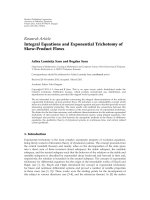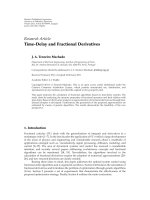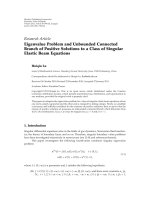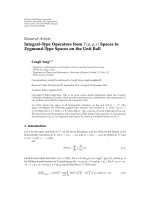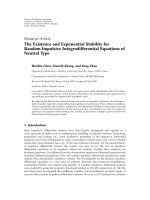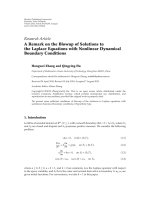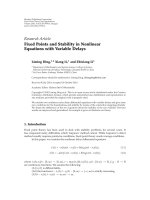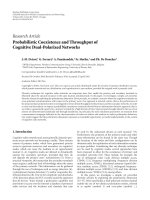Báo cáo hóa học: "Research Article Integral Equations and Exponential Trichotomy of Skew-Product Flows" doc
Bạn đang xem bản rút gọn của tài liệu. Xem và tải ngay bản đầy đủ của tài liệu tại đây (542.83 KB, 18 trang )
Hindawi Publishing Corporation
Advances in Difference Equations
Volume 2011, Article ID 918274, 18 pages
doi:10.1155/2011/918274
Research Article
Integral Equations and Exponential Trichotomy of
Skew-Product Flows
Adina Luminit¸a Sasu and Bogdan Sasu
Department of Mathematics, Faculty of Mathematics and Computer Science, West University of Timis¸oara,
V. P
ˆ
arvan Boulevard no. 4, 300223 Timis¸oara, Romania
Correspondence should be addressed to Adina Luminit¸a Sasu,
Received 24 November 2010; Accepted 1 March 2011
Academic Editor: Toka Diagana
Copyright q 2011 A. L. Sasu and B. Sasu. This is an open access article distributed under the
Creative Commons Attribution License, which permits unrestricted use, distribution, and
reproduction in any medium, provided the original work is properly cited.
We are interested in an open problem concerning the integral characterizations of the uniform
exponential trichotomy of skew-product flows. We introduce a new admissibility concept which
relies on a double solvability of an associated integral equation and prove that this provides several
interesting asymptotic properties. The main results will establish the connections between this
new admissibility concept and the existence of the most general case of exponential trichotomy.
We obtain for the first time necessary and sufficient characterizations for the uniform exponential
trichotomy of skew-product flows in infinite-dimensional spaces, using integral equations. Our
techniques also provide a nice link between the asymptotic methods in the theory of difference
equations, the qualitative theory of dynamical systems in continuous time, and certain related
control problems.
1. Introduction
Exponential trichotomy is the most complex asymptotic property of evolution equations,
being firmly rooted in bifurcation theory of dynamical systems. The concept proceeds from
the central manifold theorem and mainly relies on the decomposition of the state space
into a direct sum of three invariant closed subspaces: the stable subspace, the unstable
subspace, and the neutral subspace such that the behavior of the solution on the stable and
unstable subspaces is described by exponential decay backward and forward in time and,
respectively, the solution is bounded on the neutral subspace. The concept of exponential
trichotomy for differential equations has the origin in the remarkable works of Elaydi and
H
´
ajek see 1, 2. Elaydi and H
´
ajek introduced the concept of exponential trichotomy
for linear and nonlinear differential systems and proved a number of notable properties
in these cases see 1, 2. These works were the starting points for the development of
this subject in various directions see 3–8, and the references therein.In5 the author
2 Advances in Difference Equations
gave necessary and sufficient conditions for exponential trichotomy of difference equations
by examining the existence of a bounded solution of the corresponding inhomogeneous
system. Paper 4 brings a valuable contribution to the study of the exponential trichotomy.
In this paper Elaydi and Janglajew obtained the first input-output characterization for
exponential trichotomy see Theorem 4, page 423. More precisely, the authors proved
that a system xn 1Anxn of difference equations with An a k × k invertible
matrix on Z, has an E-H-trichotomy if and only if the associated inhomogeneous system
yn 1Anynbn has at least one bounded solution on Z for every bounded
input b.In4 the applicability area of exponential trichotomy was extended, by introducing
new concepts of exponential dichotomy and exponential trichotomy. The authors proposed
two different methods: in the first approach the authors used the tracking method and in
the second approach they introduced a discrete analogue of dichotomy and trichotomy in
variation.
A new step in the study of the exponential trichotomy of difference equations
was made in 3, where Cuevas and Vidal obtained the structure of the range of each
trichotomy projection associated with a system of difference equations which has weighted
exponential trichotomy. This approach allows them to deduce the connections between
weighted exponential trichotomy and the
h, k trichotomy on Z
and Z
−
as well as to present
some applications to the case of nonhomogeneous linear systems. In 8 the authors deduce
the explicit formula in terms of the trichotomy projections for the solution of the nonlinear
system associated with a system of difference equations which has weighted exponential
trichotomy. The first study for exponential trichotomy of variational difference equations
was presented in 6, the methods being provided directly for the infinite-dimensional case.
There we obtained necessary and sufficient conditions for uniform exponential trichotomy
of variational difference equations in terms of the solvability of an associated discrete-time
control system.
Starting with the ideas delineated by the pioneering work of Perron see 9 and
developed later in remarkable works by Coppel see 10, Daleckii and Krein see 11,
Massera and Sch
¨
affer see 12 one of the most operational tool in the study of the asymptotic
behavior of an evolution equation is represented by the input-output conditions. These
methods arise from control theory and often provide characterizations of the asymptotic
properties of dynamical systems in terms of the solvability of some associated control systems
see 4, 6, 13–21. According to our knowledge, in the existent literature, there are no input-
output integral characterizations for uniform exponential trichotomy of skew-product flows.
Moreover, the territory of integral admissibility for exponential trichotomy of skew-product
flows was not explored yet. These facts led to a collection of open questions concerning
this topic and, respectively, concerning the operational connotations and consequences in
the framework of general variational systems.
The aim of the present paper is to present for the first time a study of exponential
trichotomy of skew-product flows from the new perspective of the integral admissibility.
We treat the most general case of exponential trichotomy of skew-product flows see
Definition 2.4 which is a direct generalization of the exponential dichotomy see 13, 14, 19–
22 and is tightly related to the behavior described by the central manifold theorem.
Our methods will be based on the connections between the asymptotic properties of
variational difference equations, the qualitative behavior of skew-product flows, and control
type techniques, providing an interesting interference between the discrete-time and the
continuous-time behavior of variational systems. We also emphasize that our central purpose
is to deduce a characterization for uniform exponential trichotomy without assuming a
Advances in Difference Equations 3
priori the existence of the projection families, without supposing the invariance with respect
to the projection families or the invertibility on the unstable subspace or on the bounded
subspace.
We will introduce a new concept of admissibility which relies on a double solvability
of an associated integral equation and on the uniform boundedness of the norm of solution
relative to the norm of the input function. Using detailed and constructive methods we will
prove that this assures the existence of the uniform exponential trichotomy with all its
properties, without any additional hypothesis on the skew-product flow. Moreover, we will
show that the admissibility is also a necessary condition for uniform exponential trichotomy.
Thus, we deduce the premiere characterization of the uniform exponential trichotomy of
skew-product flows in terms of the solvability of an associated integral equation. The results
are obtained in the most general case, being applicable to any class of variational equations
described by skew-product flows.
2. Basic Definitions and Preliminaries
In this section, for the sake of clarity, we will give some basic definitions and notations and
we will present some auxiliary results.
Let X be a real or a complex Banach space. The norm on X and on LX, the Banach
algebra of all bounded linear operators on X, will be denoted by ·. The identity operator
on X will be denoted by I.
Throughout the paper R denotes the set of real numbers and Z denotes the set of real
integers. If J ∈{R, Z} then we denote J
{x ∈ J : x ≥ 0} and J
−
{x ∈ J : x ≤ 0}.
Notations
i We consider the spaces
∞
Z,X : {s : Z → X :sup
k∈Z
sk < ∞}, ΓZ,X : {s ∈
∞
Z,X : lim
k →∞
sk0}, ΔZ,X : {s ∈
∞
Z,X : lim
k →−∞
sk0} and c
0
Z,X :
ΓZ,X ∩ ΔZ,X, which are Banach spaces with respect to the norm s
∞
: sup
k∈Z
sk.
ii If p ∈ 1, ∞ then
p
Z,X{s : Z → X :
∞
k−∞
sk
p
< ∞} is a Banach space
with respect to the norm s
p
:
∞
k−∞
sk
p
1/p
.
iii Let FZ,X be the linear space of all s : Z → X with the property that sk0,
for all k ∈ Z \ Z
and the set {k ∈ Z : sk
/
0} is finite.
Let Θ,d be a metric space and let E X × Θ.
Definition 2.1. A continuous mapping σ : Θ × R → Θ is called a flow on Θ if σθ, 0θ and
σθ, s tσσθ, s,t, for all θ, s, t ∈ Θ × R
2
.
Definition 2.2. Apairπ Φ,σ is called (linear) skew-product flow on E if σ is a flow on Θ and
the mapping Φ : Θ × R
→LX, called cocycle, satisfies the following conditions:
iΦθ, 0I, for all θ ∈ Θ;
iiΦθ, s tΦσθ, s,tΦθ, s, for all θ, t, s ∈ Θ × R
2
the cocycle identity;
iii there are M ≥ 1andω>0 such that Φθ, t≤Me
ωt
, for all θ, t ∈ Θ × R
;
iv for every x ∈ X the mapping θ, t → Φθ, tx is continuous.
4 Advances in Difference Equations
Example 2.3. Let a : R → R
be a continuous increasing function with lim
t →∞
at < ∞ and
let a
s
tat s. We denote by Θ the closure of {a
s
: s ∈ R} in CR, R,d, where CR, R
denotes the space of all continuous functions u : R → R and
d
f, g
:
∞
n1
1
2
n
d
n
f, g
1 d
n
f, g
, 2.1
where d
n
f, gsup
t∈−n,n
|ft − gt|.
Let X be a Banach space and let {Tt}
t≥0
be a C
0
-semigroup on X with the infinitesimal
generator A : DA ⊂ X → X. For every θ ∈ Θ let Aθ : θ0A. We define σ : Θ × R →
Θ,σθ, ts : θt s and we consider the system
˙x
t
A
σ
θ, t
x
t
,t≥ 0,
x
0
x
0
.
A
If Φ : Θ × R
→LX, Φθ, tx T
t
0
θsdsx, then π Φ,σ is a skew-product flow on
E X × Θ. For every x
0
∈ DA,wenotethatxt :Φθ, tx
0
, f or all t ≥ 0, is the strong
solution of the system A.
For other examples which illustrate the modeling of solutions of variational equations
by means of skew-product flows as well as the existence of the perturbed skew-product
flowwereferto21see Examples 2.2 and 2.4. Interesting examples of skew-product
flows which often proceed from the linearization of nonlinear equations can be found in
7, 13, 14, 22, 23, motivating the usual appellation of linear skew-product flows.
The most complex description of the asymptotic property of a dynamical system is
given by the exponential trichotomy, which provides a complete chart of the qualitative
behaviors of the solutions on each fundamental manifold: the stable manifold, the central
manifold, and the unstable manifold. This means that the state space is decomposed at every
point of the flow’s domain—the base space—into a direct sum of three invariant closed
subspaces such that the solution on the first and on the third subspace exponentially decays
forward and backward in time, while on the central subspace the solution had a uniform
upper and lower bound see 1–6, 8.
Definition 2.4. A skew-product flow π Φ,σ is said to be uniformly exponentially trichotomic
if there are three families of projections {P
k
θ}
θ∈Θ
⊂LX, k ∈{1, 2, 3} and two constants
K ≥ 1andν>0 such that
i P
k
θP
j
θ0, for all k
/
j and all θ ∈ Θ,
ii P
1
θP
2
θP
3
θI, for all θ ∈ Θ,
iii sup
θ∈Θ
P
k
θ < ∞, for all k ∈{1, 2, 3},
ivΦθ, tP
k
θP
k
σθ, tΦθ, t, for all θ, t ∈ Θ × R
and all k ∈{1, 2, 3},
v Φθ, tx≤Ke
−νt
x, for all t ≥ 0, x ∈ Im P
1
θ and all θ ∈ Θ,
vi1/Kx≤Φθ, tx≤Kx, for all t ≥ 0, x ∈ Im P
2
θ and all θ ∈ Θ,
vii Φθ, tx≥1/Ke
νt
x, for all t ≥ 0, x ∈ Im P
3
θ and all θ ∈ Θ,
viii the restriction Φθ, t
|
:ImP
k
θ → Im P
k
σθ, t is an isomorphism, for all θ, t ∈
Θ × R
and all k ∈{2, 3}.
Advances in Difference Equations 5
Remark 2.5. We note that this is a direct generalization of the classical concept of uniform
exponential dichotomy see 13, 14, 19–22, 24, 25 and expresses the behavior described by
the central manifold theorem. It is easily seen that for P
2
θ0, for all θ ∈ Θ, one obtains the
uniform exponential dichotomy concept and the condition iii is redundant see, e.g., 19,
Lemma 2.8.
Remark 2.6. If a skew-product flow is uniformly exponentially trichotomic with respect to the
families of projections {P
k
θ}
θ∈Θ
, k ∈{1, 2, 3}, then
iΦθ, t Im P
1
θ ⊂ Im P
1
σθ, t, for all θ, t ∈ Θ × R
;
iiΦθ, t Im P
k
θIm P
k
σθ, t, for all θ, t ∈ Θ × R
and all k ∈{2, 3}.
Let π Φ,σ be a skew-product flow on E. At every point θ ∈ Θ we associate with
π three fundamental subspaces, which will have a crucial role in the study of the uniform
exponential trichotomy.
Notation
For every θ ∈ Θ we denote by Jθ the linear space of all functions ϕ : R
−
→ X with
ϕ
t
Φ
σ
θ, s
,t− s
ϕ
s
, ∀s ≤ t ≤ 0. 2.2
For every θ ∈ Θ we consider the linear space:
S
θ
x ∈ X : lim
t →∞
Φ
θ, t
x 0
2.3
called the stable subspace. We also define
B
θ
x ∈ X :sup
t≥0
Φ
θ, t
x
< ∞ and t here is ϕ ∈J
θ
with ϕ
0
x and sup
t≤0
ϕ
t
<∞
2.4
called the bounded subspace and, respectively,
U
θ
x ∈ X : there is ϕ ∈J
θ
with ϕ
0
x and lim
t →−∞
ϕ
t
0
2.5
called the unstable subspace.
Lemma 2.7. (i) If for every θ ∈ Θ, Vθ denotes one of the subspaces Sθ, Bθ or Uθ,then
Φθ, tVθ ⊂Vσθ, t, for all θ, t ∈ Θ × R
.
6 Advances in Difference Equations
(ii) If the skew-product flow π Φ,σ is uniformly exponentially trichotomic with respect
to three families of projections {P
k
θ}
θ∈Θ
⊂LX, k ∈{1, 2, 3}, then these families are uniquely
determined by the conditions in Definition 2.4. Moreover one has that
Im P
1
θ
S
θ
, Im P
2
θ
B
θ
, Im P
3
θ
U
θ
, ∀ θ ∈ Θ. 2.6
Proof. See 6, Lemma 5.4, Proposition 5.5, and Remark 5.3.
We will start our investigation by recalling a recent result obtained for the discrete-time
case. Precisely, the discrete case was treated in 6, where we formulated a first resolution
concerning the characterization of the uniform exponential trichotomy in terms of the
solvability of a system of variational difference equations. Indeed, we associated with the
skew-product flow π Φ,σ the discrete input-output system S
π
S
π
θ
θ∈Θ
, where for
every θ ∈ Θ
γ
n 1
Φ
σ
θ, n
, 1
γ
n
s
n 1
, ∀ n ∈ Z, S
π
θ
with γ ∈
∞
Z,X and s ∈FZ,X.
Definition 2.8. The pair
∞
Z,X, FZ,X is said to be uniformly admissible for the skew-
product flow π Φ,σ if there are p ∈ 1, ∞ and L>0 such that for every θ ∈ Θ the
following properties hold:
i for every s ∈FZ,X there are γ ∈ ΓZ,X and δ ∈ ΔZ,X such that the pairs γ,s
and δ, s satisfy S
π
θ
;
ii if s ∈FZ,X and γ ∈ ΓZ,X ∪ ΔZ,X is such that the pair γ,s satisfies S
π
θ
then γ
∞
≤ L s
1
;
iii if s ∈FZ,X is such that sn ∈Sσθ, n ∪Uσθ, n, for all n ∈ Z
,andγ ∈
c
0
Z,X is such that the pair γ,s satisfies S
π
θ
, then γ
∞
≤ Ls
p
.
The first connection between an input-output discrete admissibility and the uniform
exponential trichotomy of skew-product flows was obtained in 6see Theorem 5.8 and this
is given by what follows.
Theorem 2.9. Let π Φ,σ be a skew-product flow on E. π is uniformly exponentially trichotomic
if and only if the pair
∞
Z,X, FZ,X is uniformly admissible for π.
The proof of this result relies completely on discrete-time arguments and essentially
uses the properties of the associated system of variational difference equations. The natural
question is whether we may study the uniform exponential trichotomy property of skew-
product flows from a “continuous” point of view. On the other hand, in the spirit of the
classical admissibility theory see 10–12, 14, 15, 21 it would be interesting to see if the
uniform exponential trichotomy can be expressed in terms of the solvability of an integral
equation. The aim of the next section will be to give a complete resolution to these questions.
Thus, we are interested in solving for the first time the problem of characterizing the
exponential trichotomy of skew-product flows in terms of the solvability of an integral
equation and also in establishing the connections between the qualitative theory of difference
equations and the continuous-time behavior of dynamical systems, pointing out how the
Advances in Difference Equations 7
discrete-time arguments provide interesting information in control problems related with the
existence of the exponential trichotomy.
3. Main Results
Let X be a real or a complex Banach space. In this section, we will present a complete study
concerning the characterization of uniform exponential trichotomy using a special solvability
of an associated integral equation. We introduce a new and natural admissibility concept and
we show that the trichotomic behavior of skew-product flows can be studied in the most
general case, without any additional assumptions.
Notations
Let C
b
R,X{f : R → X | f continuous and bounded}, which is a Banach space with
respect to the norm |f| : sup
t∈R
ft. We consider the spaces LR,X : {f ∈ C
b
R,X |
lim
t →∞
ft0}, DR,X : {f ∈ C
b
R,X | lim
t →−∞
ft0} and let C
0
R,XLR,X ∩
DR,X. Then LR,X, DR,X and C
0
R,X are closed linear subspaces of C
b
R,X.Let
CR,X be the space of all continuous functions f : R → X with compact support and
supp f ⊂ 0, ∞.
Let p ∈ 1, ∞ and let L
p
R,X be the linear space of all Bochner measurable functions
f : R → X with the property that
R
fs
p
ds < ∞, which is a Banach space with respect
to the norm
f
p
:
R
f
s
p
ds
1/p
.
3.1
Let Θ,d be a metric space and let π Φ,σ be a skew-product flow. For every θ ∈ Θ
we consider the integral equation
f
t
Φ
σ
θ, r
,t− r
f
r
t
r
Φ
σ
θ, τ
,t− τ
u
τ
dτ, ∀t ≥ r,
E
π
θ
with f : R → X and u ∈CR,X.
Definition 3.1. The pair C
b
R,X, CR,X is said to be uniformly admissible for the skew-
product flow π Φ,σ if there are p ∈ 1, ∞ and Q>0 such that for every θ ∈ Θ the
following properties hold:
i for every u ∈CR,X there are f ∈LR,X and g ∈DR,X such that the pairs
f, u and g,u satisfy E
π
θ
;
ii if u ∈CR,X and f ∈LR,X ∪DR,X are such that the pair f, u satisfies E
π
θ
,
then |f| ≤ Q max{u
1
, u
p
};
iii if u ∈CR,X is such that ut ∈Sσθ, t∪Uσθ, t, for all t ≥ 0andf ∈ C
0
R,X
has the property that the pair f, u satisfies E
π
θ
, then |f| ≤ Qu
p
.
Remark 3.2. In the above admissibility concept, the input space is a minimal one, because all
the test functions u belong to the space CR,X.
8 Advances in Difference Equations
In what follows we will establish the connections between the admissibility and the
existence of uniform exponential trichotomy.
The first main result of this paper is as follows.
Theorem 3.3. Let π Φ,σ be a skew-product flow on E. If the pair C
b
R,X, CR,X is
uniformly admissible for π,thenπ is uniformly exponentially trichotomic.
Proof. We prove that the pair
∞
Z,X, FZ,X is uniformly admissible for π.
Indeed, let p ∈ 1, ∞ and Q>0 be given by Definition 3.1. We consider a continuous
function α : R → 0, 2 with the support contained in 0, 1 and
1
0
α
τ
dτ 1.
3.2
Let M, ω > 0 be such that Φθ, t≤Me
ωt
, for all θ, t ∈ Θ × R
. Since
1
Z,X ⊂
p
Z,X ⊂
∞
Z,X there is λ ≥ 1 such that
s
p
≤ λ
s
1
, ∀s ∈
1
Z,X
,
3.3
s
∞
≤ λ
s
1
, ∀s ∈
1
Z,X
, 3.4
s
∞
≤ λ
s
p
, ∀s ∈
p
Z,X
.
3.5
Let θ ∈ Θ.
Step 1. Let s ∈FZ,X. We consider the function
u : R → X, u
t
α
t −
t
Φ
σ
θ,
t
,t−
t
s
t
. 3.6
Then u is continuous and
u
t
≤ α
t −
t
Me
ω
s
t
, ∀t ∈ R. 3.7
Since s ∈FZ,X there is n ∈ Z
such that {k ∈ Z : sk
/
0}⊂{0, ,n}. Then, from 3.7 it
follows that supp u ⊂ 0,n 1,sou ∈CR,X. According to our hypothesis it follows that
there are f ∈LR,X and g ∈DR,X such that the pairs f, u and g,u satisfy E
π
θ
.
Then, for every n ∈ Z we obtain that
f
n 1
Φ
σ
θ, n
, 1
f
n
n1
n
Φ
σ
θ, τ
,n 1 − τ
u
τ
dτ
Φ
σ
θ, n
, 1
f
n
Φ
σ
θ, n
, 1
s
n
.
3.8
Let
γ : Z −→ X, γ
n
f
n
s
n
. 3.9
Advances in Difference Equations 9
From 3.8 we have that
γ
n 1
Φ
σ
θ, n
, 1
γ
n
s
n 1
, ∀n ∈ Z 3.10
so the pair γ,s satisfies S
π
θ
. Moreover, since f ∈LR,X and s ∈FZ,X, we deduce that
γ ∈ ΓZ,X. Since the pair g,u satisfies E
π
θ
we obtain that
g
n 1
Φ
σ
θ, n
, 1
g
n
Φ
σ
θ, n
, 1
s
n
, ∀n ∈ Z. 3.11
Taking
δ : Z −→ X, δ
n
g
n
s
n
3.12
we analogously obtain that δ ∈ ΔZ,X and the pair δ, s satisfies S
π
θ
.
Step 2. Let s ∈FR,X and let γ ∈ ΓZ,X ∪ ΔZ,X be such that the pair γ,s satisfies S
π
θ
.
We consider the functions u, f : R → X, given by
u
t
α
t −
t
Φ
σ
θ,
t
,t−
t
s
t
,
f
t
Φ
σ
θ,
t
,t−
t
γ
t
−
t1
t
α
τ −
τ
dτ
Φ
σ
θ,
t
,t−
t
s
t
.
3.13
Since s ∈FZ,X we have that u ∈CR,X. Observing that for every n ∈ Z
lim
tn1
f
t
Φ
σ
θ, n
, 1
γ
n
,
f
n 1
γ
n 1
− s
n 1
,
3.14
we deduce that f is continuous. Moreover, since s ∈FZ,X and γ ∈ ΓZ,X ∪ ΔZ,X,from
f
t
≤ Me
ω
γ
t
s
t
, ∀t ∈ R 3.15
we obtain that f ∈LR,X ∪DR,X.
Let r ∈ R. We prove that
f
t
Φ
σ
θ, r
,t− r
f
r
t
r
Φ
σ
θ, τ
,t− τ
u
τ
dτ, ∀t ≥ r.
3.16
10 Advances in Difference Equations
We set n r.Iftn, then, taking into account the way how f was defined, the relation
3.16 obviously holds. If t ≥ n 1 then there is k ∈ Z, k ≥ 1 such that tn k. Then, we
deduce that
Φ
σ
θ, r
,t− r
f
r
t
r
Φ
σ
θ, τ
,t− τ
u
τ
dτ
Φ
σ
θ, n
,t− n
γ
n
t
n1
Φ
σ
θ, τ
,t− τ
u
τ
dτ.
3.17
If k 1 then tn 1and
t
n1
Φ
σ
θ, τ
,t− τ
u
τ
dτ
t
n1
α
τ −
τ
dτ
Φ
σ
θ,
t
,t−
t
s
t
Φ
σ
θ, n 1
,t− n − 1
s
n 1
−
t1
t
α
τ −
τ
dτ
Φ
σ
θ,
t
,t−
t
s
t
.
3.18
If k ≥ 2 then
t
n1
Φ
σ
θ, τ
,t− τ
u
τ
dτ
k−1
j1
nj1
nj
Φ
σ
θ, τ
,t− τ
u
τ
dτ
t
nk
Φ
σ
θ, τ
,t− τ
u
τ
dτ
k−1
j1
Φ
σ
θ, n j
,t− n − j
s
n j
t
nk
α
τ −
τ
dτ
Φ
σ
θ, n k
,t− n − k
s
n k
k
j1
Φ
σ
θ, n j
,t− n − j
s
n j
−
t1
t
α
τ −
τ
dτ
Φ
σ
θ,
t
,t−
t
s
t
.
3.19
Advances in Difference Equations 11
From relations 3.18 and 3.19 we have that
t
n1
Φ
σ
θ, τ
,t− τ
u
τ
dτ
k
j1
Φ
σ
θ, n j
,t− n − j
s
n j
−
t1
t
α
τ −
τ
dτ
Φ
σ
θ,
t
,t−
t
s
t
.
3.20
Then, from 3.17 and 3.20 it follows that
f
t
− Φ
σ
θ, r
,t− r
f
r
−
t
r
Φ
σ
θ, τ
,t− τ
u
τ
dτ
Φ
σ
θ, n k
,t− n − k
γ
n k
− Φ
σ
θ, n
,t− n
γ
n
−
k
j1
Φ
σ
θ, n j
,t− n − j
s
n j
Φ
σ
θ, n k
,t− n − k
⎡
⎣
γ
n k
− Φ
σ
θ, n
,k
γ
n
−
k
j1
Φ
σ
θ, nj
,k− j
s
nj
⎤
⎦
.
3.21
Since the pair γ,s satisfies S
π
θ
we have that
γ
n k
Φ
σ
θ, n
,k
γ
n
k
j1
Φ
σ
θ, n j
,k− j
s
n j
.
3.22
From 3.21 and 3.22 we obtain that the relation 3.16 holds for all t ≥ r. Since r ∈ R was
arbitrary we deduce that the pair f, u satisfies E
π
θ
. Then according to our hypothesis we
have that
f
≤ Q max
u
1
,
u
p
. 3.23
In addition, we have that
u
1
≤
k∈Z
k1
k
α
t −
t
Φ
σ
θ,
t
,t−
t
s
t
dt ≤ Me
ω
s
1
3.24
and that
u
p
≤ 2Me
ω
s
p
.
3.25
12 Advances in Difference Equations
Taking
Q : 2λQMe
ω
, from relations 3.23–3.25 and 3.3 it follows that
f
≤
Q
s
1
.
3.26
Observing that fnγn − sn, for all n ∈ N,from3.26 and 3.4 we successively deduce
that
γ
∞
≤
f
s
∞
≤
Q
s
1
λ
s
1
.
3.27
Setting L
Q λ,fromrelation3.27 we deduce that
γ
∞
≤ L
s
1
. 3.28
Step 3. Let s ∈FZ,X be such that sn ∈Sσθ, n ∪Uσθ, n, for all n ∈ Z
and let
γ ∈ c
0
Z,X be such that the pair γ,s satisfies S
π
θ
. We consider the functions u, f : R → X,
given by
u
t
α
t −
t
Φ
σ
θ,
t
,t−
t
s
t
,
f
t
Φ
σ
θ,
t
,t−
t
γ
t
−
t1
t
α
τ −
τ
dτ
Φ
σ
θ,
t
,t−
t
s
t
.
3.29
Using analogous arguments with those used in the Step 2 we obtain that u ∈CR,X,f ∈
C
0
R,X and the pair f, u satisfies E
π
θ
. Moreover, using Lemma 2.7 we have that ut ∈
Sσθ, t ∪Uσθ, t, for all t ≥ 0. Then, according to our hypothesis we deduce that
f
≤ Q
u
p
.
3.30
Since fnγn − sn, for all n ∈ N,using3.30 and 3.5 we obtain that
γ
∞
≤
f
s
∞
≤ Q
u
p
λ
s
p
.
3.31
Observing that
u
p
≤ 2Me
ω
s
p
3.32
from 3.31 and 3.32 we deduce that
γ
∞
≤
2QMe
ω
λ
s
p
≤ L
s
p
, 3.33
where L 2λQMe
ω
λ.
Finally, from Steps 1–3 and relations 3.28 and 3.33 we deduce that the pair
∞
Z,X, FZ,X is uniformly admissible for the skew-product flow π Φ,σ.By
applying Theorem 2.9 we conclude that π is uniformly exponentially trichotomic.
Advances in Difference Equations 13
The natural question arises whether the integral admissibility given by Definition 3.1 is
also a necessary condition for the existence of the uniform exponential trichotomy. To answer
this question, in what follows, our attention will focus on the converse implication of the
result given by Theorem 3.3. Specifically, our study will motivate the admissibility concept
introduced in this paper and will point out several qualitative aspects. First of all, we prove
a technical result.
Proposition 3.4. Let π Φ,σ be a skew-product flow which is uniformly exponentially trichotomic
with respect to the families of projections {P
k
θ}
θ∈Θ
,k ∈{1, 2, 3}.Letθ ∈ Θ,letf ∈ C
b
R,X, and
let u ∈CR,X be such that the pair f, u satisfies E
π
θ
. We denote
f
k
t
: P
k
σ
θ, t
f
t
,u
k
t
: P
k
σ
θ, t
u
t
, ∀t ∈ R, ∀k ∈
{
1, 2, 3
}
3.34
and let Φ
3
σθ, s, t − s
−1
|
denote the inverse of the operator Φσθ, s,t − s
|
: P
3
σθ, s →
P
3
σθ, t, for all t ≥ s. The following assertions hold:
i the functions f
1
and f
3
have the following representations
f
1
t
t
−∞
Φ
σ
θ, τ
,t− τ
u
1
τ
dτ, ∀t ∈ R
3.35
f
3
t
−
∞
t
Φ
3
σ
θ, t
,τ − t
−1
|
u
3
τ
dτ, ∀t ∈ R;
3.36
ii for every p ∈ 1, ∞ there is Q
p
> 0 which does not depend on θ, f or u such that
f
k
≤ Q
p
u
p
, ∀k ∈
{
1, 3
}
.
3.37
Proof. Since u ∈CR,X there is h>0 such that supp u ⊂ 0,h.LetK, ν ∈ 0, ∞ be given by
Definition 2.4 and let λ
k
sup
θ∈Θ
P
k
θ,k ∈{1, 2, 3}.
i Since the pair f, u satisfies E
π
θ
we have that
f
k
t
Φ
σ
θ, r
,t− r
f
k
r
t
r
Φ
σ
θ, τ
,t− τ
u
k
τ
dτ, ∀t ≥ r, ∀k ∈
{
1, 2, 3
}
.
3.38
Since supp u ⊂ 0,h from 3.38 we have that f
1
tΦσθ, r,t− rf
1
r, for all r ≤ t ≤ 0.
Let t ≤ 0. Then we deduce that
f
1
t
≤ Ke
−νt−r
f
1
r
≤ λ
1
Ke
−νt−r
f
, ∀r ≤ t.
3.39
For r →−∞in 3.39 we obtain that f
1
t0, for all t ≤ 0. This shows that relation 3.35
holds for all t ≤ 0. For t>0from3.38 we have that
f
1
t
t
0
Φ
σ
θ, τ
,t− τ
u
1
τ
dτ
t
−∞
Φ
σ
θ, τ
,t− τ
u
1
τ
dτ
3.40
so relation 3.35 holds for every t ∈ R.
14 Advances in Difference Equations
For every t ≥ r ≥ h from 3.38 we have that f
3
tΦσθ, r,t− rf
3
r. This implies
that
λ
3
f
≥
f
3
t
≥
1
K
e
νt−r
f
3
r
, ∀t ≥ r ≥ h
3.41
so we deduce that
f
3
r
≤ λ
3
K
f
e
−νt−r
, ∀t ≥ r ≥ h.
3.42
From relation 3.42 it follows that f
3
r0, for all r ≥ h. In particular, we have that relation
3.36 holds for t ≥ h. For t ≤ h from 3.38 we obtain that
0 f
3
h
Φ
σ
θ, t
,h− t
f
3
t
h
t
Φ
σ
θ, τ
,h− τ
u
3
τ
dτ
3.43
which implies that
f
3
t
−
h
t
Φ
3
σ
θ, t
,τ − t
−1
|
u
3
τ
dτ −
∞
t
Φ
3
σ
θ, t
,τ − t
−1
|
u
3
τ
dτ
3.44
for all t ≤ h. Thus, we conclude that relation 3.36 holds for every t ∈ R.
ii Let p ∈ 1, ∞ and let q p/p − 1 . Setting Q
p
K1/νq
1/q
max{λ
1
,λ
3
} and
using H
¨
older’s inequality we deduce that
f
k
t
≤ Q
p
u
p
, ∀t ∈ R, ∀k ∈
{
1, 3
}
.
3.45
The second main result of the paper is as follows.
Theorem 3.5. Let π Φ,σ be a skew-product flow. If π is uniformly exponentially trichotomic,
then the pair C
b
R,X,CR,X is uniformly admissible for π.
Proof. Let K, ν ∈ 0, ∞ be two constants and let {P
k
θ}
θ∈Θ
, k ∈{1, 2, 3} be the families of
projections given by Definition 2.4.Wesetλ
k
: sup
θ∈Θ
P
k
θ. For every k ∈{2, 3} and
every θ, t ∈ Θ × R
we denote by Φ
k
θ, t
−1
|
the inverse of the operator Φθ, t
|
:ImP
k
θ →
Im P
k
σθ, t.
For every ϕ : R → X and every k ∈{1, 2, 3} we denote by
ϕ
k
t
P
k
σ
θ, t
ϕ
t
, ∀t ∈ R. 3.46
Then ϕ
k
t ∈ Im P
k
σθ, t, for all t ∈ R and all k ∈{1, 2, 3} and ϕt
3
k1
ϕ
k
t, for all
t ∈ R.
Let p ∈ 1, ∞ and let Q
p
> 0 be given by Proposition 3.4. We prove that all the
properties from Definition 3.1 are fulfilled.
Let θ ∈ Θ.
Advances in Difference Equations 15
Step 1. Let u ∈CR,X, u
/
0. We consider the functions f, g : R → X defined by
f
t
t
−∞
Φ
σ
θ, τ
,t− τ
u
1
τ
dτ −
∞
t
Φ
2
σ
θ, t
,τ − t
−1
|
u
2
τ
dτ
−
∞
t
Φ
3
σ
θ, t
,τ − t
−1
|
u
3
τ
dτ.
g
t
t
−∞
Φ
σ
θ, τ
,t− τ
u
1
τ
dτ
t
−∞
Φ
σ
θ, τ
,t− τ
u
2
τ
dτ
−
∞
t
Φ
3
σ
θ, t
,τ − t
−1
|
u
3
τ
dτ.
3.47
Since u ∈CR,X we have that f and g are correctly defined and continuous. Let h>0be
such that supp u ⊂ 0,h. Setting x
1
h
0
Φσθ, τ,h− τu
1
τdτ, x
2
h
0
Φ
2
θ, τ
−1
|
u
2
τdτ
and x
3
h
0
Φ
3
θ, τ
−1
|
u
3
τdτ, we have that x
1
∈ Im P
1
σθ, h and x
k
∈ Im P
k
θ,for
k ∈{2, 3}.
We observe t hat ft−Φ
2
σθ, t, −t
−1
|
x
2
− Φ
3
σθ, t, −t
−1
|
x
3
, for all t ≤ 0, which
implies that
f
t
≤ K
x
2
x
3
, ∀t ≤ 0. 3.48
In addition, we have that ftΦσθ, h,t− hx
1
, for all t ≥ h. This implies that
f
t
≤ Ke
−νt−h
x
1
, ∀t ≥ h.
3.49
Since f is continuous from relations 3.48 and 3.49 it follows that f ∈LR,X.Using
similar arguments we deduce that g ∈DR,X. An easy computation shows that the pairs
f, u and g,u satisfy E
π
θ
.
If u 0, then we take f g ≡ 0.
Step 2. Let u ∈CR,X and let f ∈LR,X ∪DR,X be such that the pair f, u satisfies
E
π
θ
.
Suppose that f ∈LR,X.FromProposition 3.4 we have that
f
k
≤ Q
p
u
p
, ∀k ∈
{
1, 3
}
.
3.50
Let h>0 be such that supp u ⊂ 0,h. Since
f
2
t
Φ
σ
θ, r
,t− r
f
2
r
t
r
Φ
σ
θ, τ
,t− τ
u
2
τ
dτ, ∀t ≥ r
3.51
16 Advances in Difference Equations
for t ≥ h we deduce that f
2
tΦσθ, h,t− hf
2
h. Since f ∈LR,X we obtain that
1
K
f
2
h
≤
f
2
t
≤ λ
2
f
t
−→ 0, as t −→ ∞
3.52
so f
2
h0. This implies that f
2
t0, for all t ≥ h. Moreover, using 3.51,fort<hwe have
that
0 f
2
h
Φ
σ
θ, t
,h− t
f
2
t
h
t
Φ
σ
θ, τ
,h− τ
u
2
τ
dτ
3.53
which implies that
f
2
t
−
h
t
Φ
2
σ
θ, t
,τ − t
−1
|
u
2
τ
dτ, ∀t ≤ h.
3.54
Then, we obtain that
f
2
t
≤ Kλ
2
h
t
u
τ
dτ ≤ Kλ
2
u
1
.
3.55
Setting Q 2Q
p
Kλ
2
from relations 3.50 and 3.55 it follows that
f
≤
3
k1
f
k
≤ Q max
u
p
,
u
1
.
3.56
The case f ∈DR,X can be treated using similar arguments with those used above.
Step 3. Let u ∈CR,X be such that ut ∈Sσθ, t ∪Uσθ, t, for all t ≥ 0andletf ∈
C
0
R,X be such that the pair f, u satisfies E
π
θ
.
Since u ∈CR,X and ut ∈Sσθ, t ∪Uσθ, t, for all t ≥ 0, using Lemma 2.7 we
deduce that u
2
t0, for all t ∈ R. Since the pair f, u satisfies E
π
θ
we obtain that
f
2
t
Φ
σ
θ, r
,t− r
f
2
r
, ∀t ≥ r. 3.57
Let r ∈ R. Since f ∈ C
0
R,X,usingrelation3.57 we have that
1
K
f
2
r
≤
f
2
t
≤ λ
2
f
t
−→ 0, as t −→ ∞
3.58
so f
2
r0, for all r ∈ R. This shows that, in this case, f f
1
f
3
.
If Q>0 is given by Step 2, we deduce that
f
≤
f
1
f
3
≤ 2Q
p
u
p
≤ Q
u
p
3.59
and the proof is complete.
Advances in Difference Equations 17
The central result of this paper is as follows.
Theorem 3.6. A skew-product flow π Φ,σ is uniformly exponentially trichotomic if and only if
the pair C
b
R,X, CR,X is uniformly admissible for π.
Proof. This follows from Theorems 3.3 and 3.5.
Remark 3.7. The above result establishes for the first time in the literature a necessary and
sufficient condition for the existence of the uniform exponential trichotomy of skew-product
flows, based on an input-output admissibility with respect to the associated integral equation.
The chart described by our method allows a direct analysis of the asymptotic behavior
of skew-product flows, without assuming a priori the existence of a projection families,
invariance properties or any reversibility properties. Moreover, the study is done in the most
general case, without any additional assumptions concerning the flow or the cocycle.
Acknowledgments
The first author is supported by CNCSIS-UEFISCDI, project PN II-IDEI code 1081/2008 no.
550/2009 and the second author is supported by CNCSIS-UEFISCDI, project PN II-IDEI code
1080/2008 no. 508/2009.
References
1 S. Elaydi and O. H
´
ajek, “Exponential trichotomy of differential systems,” Journal of Mathematical
Analysis and Applications, vol. 129, no. 2, pp. 362–374, 1988.
2 S. Elaydi and O. H
´
ajek, “Exponential dichotomy and trichotomy of nonlinear differential equations,”
Differential and Integral Equations, vol. 3, no. 6, pp. 1201–1224, 1990.
3 C. Cuevas and C. Vidal, “Weighted exponential trichotomy of linear difference equations,” Dynamics
of Continuous, Discrete & Impulsive Systems. Series A, vol. 15, no. 3, pp. 353–379, 2008.
4 S. Elaydi and K. Janglajew, “Dichotomy and trichotomy of difference equations,” Journal of Difference
Equations and Applications, vol. 3, no. 5-6, pp. 417–448, 1998.
5 G. Papaschinopoulos, “On exponential trichotomy of linear difference equations,” Applicable Analysis,
vol. 40, no. 2-3, pp. 89–109, 1991.
6 A. L. Sasu and B. Sasu, “Exponential trichotomy for variational difference equations,” Journal of
Difference Equations and Applications, vol. 15, no. 7, pp. 693–718, 2009.
7 B G. Wang and W T. Li, “Limit set trichotomy and dichotomy for skew-product semiflows with
applications,” Nonlinear Analysis, vol. 71, pp. 2834–2839, 2009.
8 C. Vidal, C. Cuevas, and L. del Campo, “Weighted exponential trichotomy of difference equations,”
in Dynamic Systems and Applications. Vol. 5, pp. 489–495, Dynamic, Atlanta, Ga, USA, 2008.
9 O. Perron, “Die Stabilit
¨
atsfrage bei Differentialgleichungen,” Mathematische Zeitschrift, vol. 32, no. 1,
pp. 703–728, 1930.
10 W. A. Coppel, Dichotomies in Stability Theory, vol. 629 of Lecture Notes in Mathematics, Springer, Berlin,
Germany, 1978.
11
J. L. Daleckii and M. G. Krein, Stability of Solutions of Differential Equations in Banach Space, vol. 43 of
Translations of Mathematical Monographs, American Mathematical Society, Providence, RI, USA, 1974.
12 J. L. Massera and J. J. Sch
¨
affer, Linear Differential Equations and Function Spaces, vol. 21 of Pure and
Applied Mathematics, Academic Press, New York, NY, USA, 1966.
13 S N. Chow and H. Leiva, “Existence and roughness of the exponential dichotomy for skew-product
semiflow in Banach spaces,” Journal of Differential Equations, vol. 120, no. 2, pp. 429–477, 1995.
14 M. Megan, A. L. Sasu, and B. Sasu, “Perron conditions for pointwise and global exponential
dichotomy of linear skew-product flows,” Integral Equations and Operator Theory, vol. 50, no. 4, pp.
489–504, 2004.
18 Advances in Difference Equations
15 N. Van Minh, F. R
¨
abiger, and R. Schnaubelt, “Exponential stability, exponential expansiveness, and
exponential dichotomy of evolution equations on the half-line,” Integral Equations and Operator Theory,
vol. 32, no. 3, pp. 332–353, 1998.
16 N. V. Minh, G. M. N’Gu
´
er
´
ekata, and R. Yuan, Lectures on the Asymptotic Behavior of Solutions of
Differential Equations, Nova Science, New York, NY, USA, 2008.
17 B. Sasu, “New criteria for exponential expansiveness of variational difference equations,” Journal of
Mathematical Analysis and Applications, vol. 327, no. 1, pp. 287–297, 2007.
18 B. Sasu, “Robust stability and stability r adius for variational control systems,” Abstract and Applied
Analysis, vol. 2008, Article ID 381791, 29 pages, 2008.
19 B. Sasu, “On dichotomous behavior of variational difference equations and applications,” Discrete
Dynamics in Nature and Society, vol. 2009, Article ID 140369, 16 pages, 2009.
20 B. Sasu, “Input-output control systems and dichotomy of variational difference equations,” Journal of
Difference Equations and Applications. In press.
21 A. L. Sasu and B. Sasu, “Integral equations in the study of the asymptotic behavior of skew-product
flows,” Asymptotic Analysis, vol. 68, no. 3, pp. 135–153, 2010.
22 S N. Chow and H. Leiva, “Unbounded perturbation of the exponential dichotomy for evolution
equations,” Journal of Differential Equations, vol. 129, no. 2, pp. 509–531, 1996.
23 C. Foias¸, G. R. Sell, and R. Temam, “Inertial manifolds for nonlinear evolutionary equations,” Journal
of Differential Equations, vol. 73, no. 2, pp. 309–353, 1988.
24 T. Diagana, “Existence of pseudo-almost automorphic mild solutions to some nonautonomous partial
evolution equations,” Advances in Difference Equations, vol. 2011, Article ID 895079, 23 pages, 2011.
25 T. Diagana, “Existence of weighted pseudo-almost periodic solutions to some classes of nonau-
tonomous partial evolution equations,” Nonlinear Analysis: Theory, Methods & Applications, vol. 74,
no. 2, pp. 600–615, 2011.

